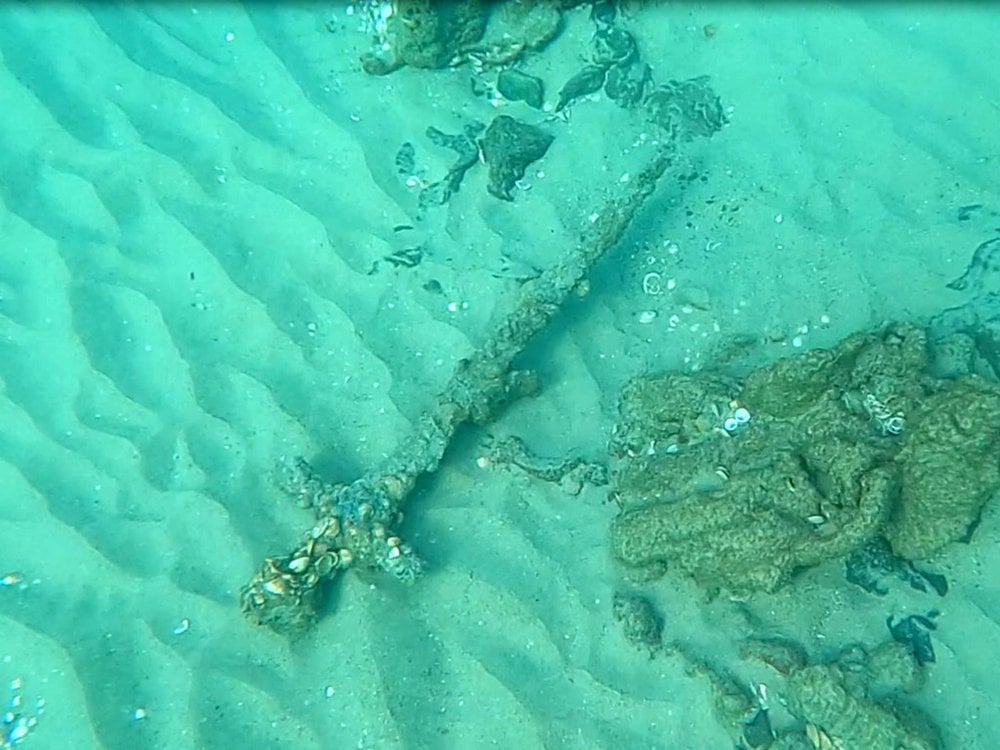
An Israeli scuba diver enjoying an outing in the Mediterranean made a stupendous find this past week, spotting a 900-year-old Crusader sword, encrusted with barnacles, making it look like something out of a movie — but it is real.
The four-foot-long sword — still quite fearsome-looking — is encrusted in marine organisms but otherwise in “perfect condition,” according to experts. This is the kind of find that keeps amateur treasure hunters going, hoping they can uncover such a treasure for themselves.
Shlomi Katzin, a scuba diver exploring the seabed in a cove in Carmel, not far from his home in northern Israel, spotted the sword sitting peacefully atop the sand, as if it had been gently placed there just recently, according to a report in Smithsonian magazine.
Katzin, who lives in the town of Atlit, also was able to recover other centuries-old artifacts on the sea bed, where shifting sands are the reason why the items were suddenly visible in the clear waters of the Mediterranean, according to a report by Israel21c.
Naturally, the sword’s condition shows that has had almost a millennia of sea life attached to it, but the fact that it is in one piece constitutes a remarkable find. As a responsible diver, Katzin reported his amazing discovery to the Israel Antiquities Authority’s (IAA) robbery prevention unit.
Crusader Sword “beautiful and rare find”
IAA inspector Nir Distelfeld said in a statement “The sword, which has been preserved in perfect condition, is a beautiful and rare find and evidently belonged to a Crusader knight.
“It was found encrusted with marine organisms, but is apparently made of iron. It is exciting to encounter such a personal object, taking you 900 years back in time to a different era, with knights, armor and swords.”
The Times of Israel stated in a report that archaeologists had already been monitoring the cove which was known to have harbored ships for millennia. Human history in the area stretches back as far as 4,000 years ago.
Disturbances in the sea can cause such objects to appear over time and an increase in the number of recreational divers in certain areas usually means that more such treasures have been found recently, according to Koby Sharvit, the director of the IAA’s marine archaeology unit.
“Even the smallest storm moves the sand and reveals areas on the seabed — meanwhile burying others,” Sharvit adds.
In addition to the sword, Katzin spotted pottery fragments and stone and metal anchors as well.
Beginning in the 11th century, European leaders sent armies to the Middle East in a quest to retake the Holy Land from its Muslim rulers at the time.
The sultan Saladin recaptured the city of Jerusalem from the Crusaders in 1187 however, causing, England’s Richard I (the Lionheart) to take up arms and journey south to reconquer the area as part of the Third Crusade. His Crusaders made their way south along Israel’s coast from Acre to Jaffa.
Ultimately, it was all for nought, as Richard failed to retake Jerusalem, but a three-year truce was eventually negotiated with Saladin. Known as the Treaty of Jaffa, the agreement ensured that Christian pilgrims would once again be allowed to visit Jerusalem, which was the main thrust of the Crusader movement.
Saladin also recognized the Crusaders’ rule of the Levantine coast as far south as Jaffa. Both sides had become exhausted by the struggle, Richard needed to return to Europe in order to protect his patrimony from the aggression of Philip of France, and Palestine was in a ruinous state by that point, historians say.
Israeli Antiquities officials, including Sa’ar Nudel, an archaeologist who studies Crusade-era weapons, state that since the sword is still covered in a variety of marine life, including extremely hard barnacles, there is not much more that can be gleaned from looking at it now.
A Haaretz report states that both Crusader knights and their Muslim Ayyubid and Mamluk opponents all used straight swords of a similar size and shape, according to archaeologist Rafi Lewis.
“The basic shape of the weapon, a straight sword, didn’t evolve much from the time of the Vikings to the 14th century.”
Sharvit states that the fact that the sword was found over 600 feet off the shoreline indicates that it was a Crusader’s weapon, however, because Muslim forces which had built fortifications along the coast didn’t travel out to sea themselves.
“They destroyed the coastal cities so the Crusaders couldn’t return and reconquer the Holy Land,” the archaeologist explains to Haaretz.
The IAA’s National Treasures Department has now taken custody of the artifact; its scientists plan to clean and study the weapon before making it available to the public to see in museum in the future.
See all the latest news from Greece and the world at Greekreporter.com. Contact our newsroom to report an update or send your story, photos and videos. Follow GR on Google News and subscribe here to our daily email!



